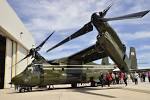
Marine Helicopter Squadron 1
HMX-1 was the first Marine rotary-wing squadron. It “stood up” at Marine Corps Airfield Quantico in Virginia on 1 December 1947 and has been located there ever since. Its activation was the first operational move that started a revolution in Marine aviation and tactical doctrine.
The squadron, initially manned by seven officers and three enlisted men, quickly grew and mustered 18 pilots and 81 enlisted men when the first helicopters, Sikorsky HO3S-1s, arrived. These first primitive machines carried only the pilot and up to three lightly armed troops, but they formed the basis for testing helicopter doctrine described in Marine Corps Schools operational manual Phib-31. Eventually, HMX-1 received a mix of early model helicopters with the addition of Piasecki HRP transports and Bell HTL trainers to test doctrine before the Korean War.
On 8 May 1948, HMX-1 pilots flew from Quantico to Norfolk, Virginia, to board the escort carrier Palau (CVE 122). The fly-on operation was described by HMX-1commanding officer Colonel Edward C. Dyer as a “complete shambles [with] sailors running all over the place in mortal danger of walking into tail rotors, and the Marines were totally disorganized as well. It was complete bedlam, there was no organization and no real system [in place].” By the next day, however, the Navy and Marine Corps were using the same basic ship-board flight operations procedures practiced today—circular lines delineated danger areas as well as personnel staging areas and approach lanes. Five days later, the HO3S-1s delivered 66 men and several tons of equipment to Camp Lejeune, North Carolina’s Onslow Beach during command post exercise Packard II.
The following year a similar exercise employed eight HRPs, three HO3Ss, and a single HTL. During Exercise Packard III, the HRP “Flying Banana” troop transports were carrier borne, the HTL was loaded on an LST for command and control, and the HO3Ss stayed ashore as rescue aircraft. The HRPs brought 230 troops and 14,000 pounds of cargo ashore even though choppy seas swamped several landing craft and seriously disrupted operational maneuvers. Many consider this superb performance to be the key factor in the acceptance of the helicopter as a viable ship-to-shore method, thus paving the way for the integration of rotary-wing aircraft into Marine aviation.
In 1957, HMX-1 acquired an unexpected mission— transporting the President of the United States. Helicopters were only considered for emergency situations until President Dwight D. Eisenhower used an HMX-1 Sikorsky HUS Sea Horse helicopter for transportation from his summer home on Narragansett Bay. After that, Marine helicopters were routinely used to move the President from the White House lawn to Andrews Air Force Base, the home of presidential plane “Air Force One.” That transport mission became a permanent tasking in 1976 and continues to this day.
Currently mustering more than 700 personnel, HMX-1 is the largest Marine Corps helicopter squadron. It is divided into two sections. The “White” side flies two unique helicopters—both specially configured Sikorsky executive transports, the VH-3D Sea King and the VH-60N Seahawk. The “Green” side provides basic helicopter indoctrination training for ground troops, tests new concepts and equipment, and assists the Marine air weapons and tactics squadron. Unlike any other Marine squadron, HMX-1 answers to three distinct chains-of-command: the Marine Corps deputy chief of staff for air at Headquarters Marine Corps; the White House military office; and the operational test and evaluation force commander at Norfolk. Marine Helicopter Squadron 1 was not only the first such Marine unit, it also currently holds a unique place in naval aviation.




